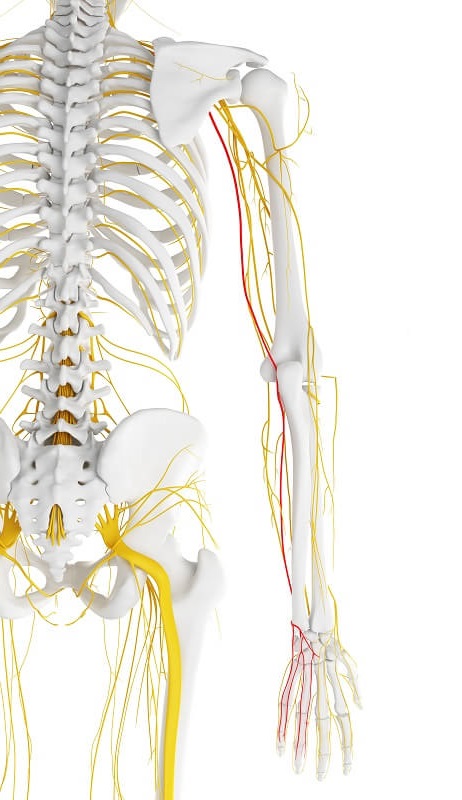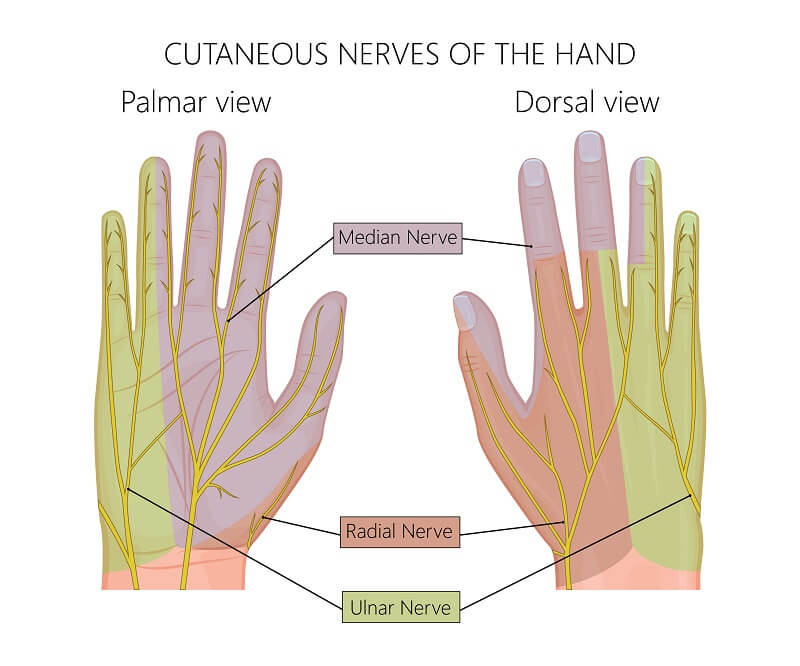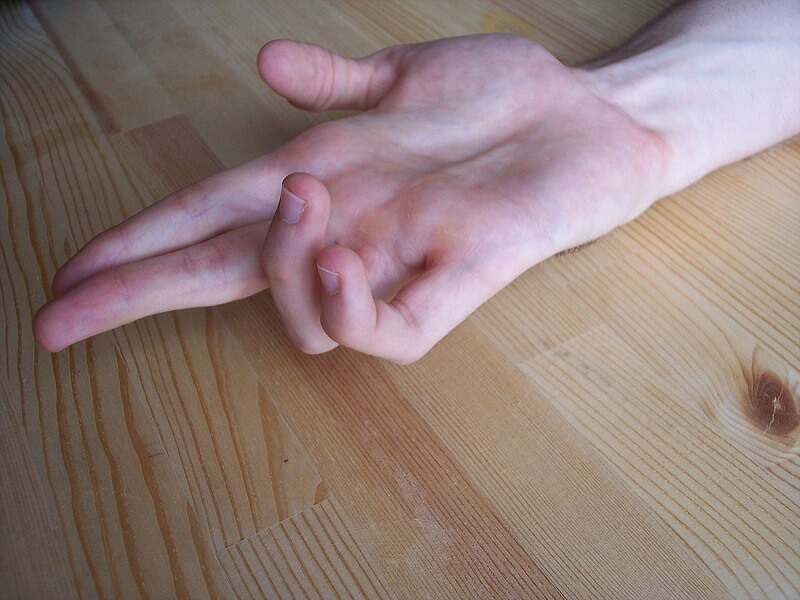Definition
The ulnar nerve, sometimes called the ‘funny bone,’ is one of the three main nerves in the human arm. It has both motor and sensory functions and provides motor function to most of the hand, including the fine movements of the fingers. The ulnar nerve is commonly injured due to compression or trauma, but these injuries are usually easily fixed with treatment.

Anatomy of the Ulnar Nerve
There are three major nerves in the arm: the median nerve, the ulnar nerve, and the radial nerve. The ulnar nerve gets its name from its proximity to the ulnar bone, which is the inner of the two bones in the forearm (the other being the radial bone).
The ulnar nerve is one of the five nerves that arise from the brachial plexus, which is a collection of nerves that communicate signals from your spinal cord to your upper arm to your hand. Specifically, the ulnar nerve is a continuation of the medial cord of the brachial plexus.
The ulnar nerve extends from the neck down the upper arm and forearm, descending to the wrists, hands, and fingers. It runs down the medial side of the arm (i.e., the inner arm). Importantly, it descends behind the medial epicondyle of the humerus, which is the region where tendons and ligaments attach the bone at the elbow. This site of the ulnar nerve is very prone to injury.
When it reaches the forearm, it forms three branches: the muscular branches, the palmar cutaneous branch, and the dorsal cutaneous branch.
- The muscular branches innervate two muscles in the forearm (the flexor carpi ulnaris and the flexor digitorum profundus).
- The palmar cutaneous branch is small and innervates the center of the palm
- The dorsal cutaneous branch supplies sensation to the little finger and the ring finger.
The ulnar nerve enters the hand at the wrist via the ulnar canal, also called Guyon’s canal. In the hand, it forms two branches: the superficial branch (mainly sensory functions) and the deep branch (mainly motor functions).

Funny Bone
The ulnar nerve is the scientific name for the ‘funny bone,’ which is actually not a bone at all. This name may have arisen due to its proximity to the humerus bone. An alternative explanation is the strange sensation that occurs when the ulnar nerve is struck, which is a tingly feeling with a dull ache.
Function of the Ulnar Nerve
The ulnar nerve is a mixed nerve, meaning it carries both sensory and motor axons. It provides motor function to most of the hand and part of the forearm. It provides sensory nerve supply to the skin in the middle of the forearm, wrist, and two fingers.
Motor Function
The motor functions of the ulnar nerve are to control the movements of the hand and some of the forearm. It innervates almost all of the muscles of the hand, controlling the fine movements of the fingers. As a result, it is sometimes called the musician’s nerve.
The only muscles it does not control in the hand are the thenar muscles (the muscles of the thumb) and the two lateral lumbricals (the muscles that flex the index and middle fingers).
The ulnar nerve also has motor functions in two muscles of the forearm. These muscles are the flexor carpi ulnaris muscle, which flexes the hand at the wrist, and the medial half of the flexor digitorum profundus, which flexes the fingers.
Sensory Function
The ulnar nerve plays a sensory role by innervating the medial one and a half fingers, and the associated palm area. In other words, it communicates external signals from the region covering the little finger and half of the ring finger – as well as the area of the palm beneath them – to the brain.

Damage and Injury to the Ulnar Nerve
Injury to the ulnar nerve is common. This is because it is the largest nerve in the human body that is not protected by muscle or bone.
Ulnar nerve injury can occur as a result of trauma, such as a fracture or blunt force injury. However, injuries of the ulnar nerve are usually a result of the nerve becoming ‘pinched’ (also called compression of the nerve, or entrapment.)
Ulnar Nerve Entrapment
Ulnar nerve entrapment (also called ulnar nerve compression) can be associated with both motor symptoms (such as muscle weakness) and sensory symptoms (such as numbness or tingling). It can also cause significant pain.
Ulnar nerve entrapment most commonly occurs around the elbow, particularly at the inner elbow, which is called cubital tunnel syndrome. However, it can happen anywhere along the nerve between the wrist and upper arm.
The effects of the injury are related to the location along the nerve at which the injury occurred. Usually, the symptoms are felt in the hand, and most often occur when the elbow is bent. Symptoms include numbness in the ring and pinky fingers, a weak grip, and difficulty controlling the fine motor skills of the fingers.
Diagnosis
Ulnar nerve damage can be easily diagnosed because of its control over the movement and sensations in the hands.
The test that is used to identify damage to the ulnar nerve (ulnar nerve palsy) is called the Froment’s Sign. This test will be positive if ulnar nerve entrapment is present.
To carry out the test, the patient will hold a sheet of paper between their thumb and index finger. The physician will then pull at the paper. If the ulnar nerve is functional, the individual should easily keep hold of the paper. If damage to the ulnar nerve is present, they will be unable to counteract the physician pulling and will release the paper, or they will have to compensate by squeezing the paper at the tip of their thumb.
In more advanced cases of the illness, an ‘ulnar claw’ could be present. This is a deformity of the hand that occurs when the ulnar nerve is damaged. People with this condition cannot fully extend their little and ring fingers.

Non-Surgical Treatment
Treatment for milder cases of compression of the ulnar nerve is usually non-surgical. Therapies include using anti-inflammatory medication to control swelling and pain, using splints to straighten the joint when sleeping or resting, and exercises to ease the nerve into the correction position.
A common exercise is called the ulnar nerve glide, in which you make an ‘okay’ sign with your hand, bend your elbow, and lift your forearm towards your shoulder repeatedly.
If these approaches fail, surgery could be offered.
Surgical Treatment
If non-surgical approaches fail, or if the symptoms are severe, surgery could be offered. These surgeries can even be performed under local anesthetic.
Cubital tunnel release is a surgery to correct ulnar nerve entrapment at the elbow. The surgeon will cut away any tissue that is tight around the nerve, releasing the pressure.
Ulnar nerve anterior transposition is a surgery in which the surgeon will move the position of the ulnar nerve to prevent pressure from building up.
A medial epicondylectomy involves removing the medial epicondyle, which is the bony mass on the inside of your elbow. This helps to reduce the pressure on the ulnar nerve.
People with ulnar nerve entrapment usually make a full (or almost full) recovery either on their own or with treatment.
Prevention
Ulnar nerve damage or entrapment is usually caused by tasks that involve repeated elbow bending. For example, cigarette smoking, playing tennis, playing golf, leaning on a desk while working, or repeatedly using a cell phone.
Reducing these tasks can help to prevent ulnar nerve damage. Simply training yourself not to lean on your elbow so much and to straighten your arm where possible will reduce the pressure on the nerve.
Quiz
